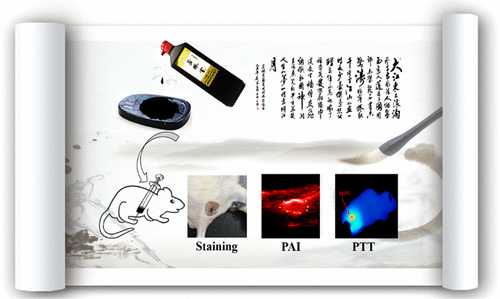Credit: American Chemical Society
For hundreds of years, Chinese calligraphers have used a plant-based ink to create beautiful messages and art. Now, one group reports in ACS Omega that this ink could noninvasively and effectively treat cancer cells that spread, or metastasize, to lymph nodes.
As cancer cells leave a tumor, they frequently make their way to lymph nodes, which are part of the immune system. In this case, the main treatment option is surgery, but this can result in complications. Photothermal therapy (PTT) is an emerging noninvasive treatment option in which nanomaterials are injected and accumulate in cancer cells. A laser heats up the nanomaterials, and this heat kills the cells. Many of these nanomaterials are expensive, difficult-to-make and toxic.
However, a traditional Chinese ink called Hu-Kaiwen ink (Hu-ink) has similar properties to the nanomaterials used in PTT. For example, they are the same color, and are both carbon-based and stable in water. So Wuli Yang and colleagues wanted to see if Hu-ink could be a good alternative material for PTT.
The researchers analyzed Hu-ink and found that it consists of nanoparticles and thin layers of carbon. When Hu-ink was heated with a laser, its temperature rose by 131 degrees Fahrenheit, much higher than current nanomaterials. Under PPT conditions, the Hu-ink killed cancer cells in a laboratory dish, but under normal conditions, the ink was non-toxic. This was also the scenario observed in mice with tumors. The researchers also noted that Hu-ink could act as a probe to locate tumors and metastases because it absorbs near-infrared light, which goes through skin.
More information: Sheng Wang et al. New Application of Old Material: Chinese Traditional Ink for Photothermal Therapy of Metastatic Lymph Nodes, ACS Omega (2017). DOI: 10.1021/acsomega.7b00993
Abstract
Finding a simple and effective strategy to eliminate tumor metastatic lymph nodes is highly desired in clinical tumor treatment. Herein, we reported a Chinese traditional ink (Hu-ink)-based treatment for photothermal therapy (PTT) of tumor metastatic lymph nodes. By simple dilution, stable Chinese traditional ink dispersion was obtained, which presents excellent photothermal effect because of its high absorption in near-infrared (NIR) region. Meanwhile, as revealed by staining and photoacoustic imaging, Hu-ink could transfer to nearby lymph nodes after directly injected into the primary tumors. Under the guidance of dual-modality mapping, the metastatic sentinel lymph nodes could be subsequently eliminated by NIR irradiation. The good biocompatibility of Hu-ink has also been verified by a series of experiments. Therefore, the Hu-ink-based treatment exhibits great potential for PTT of tumor metastatic lymph nodes in future clinical practice.
Provided by American Chemical Society






















